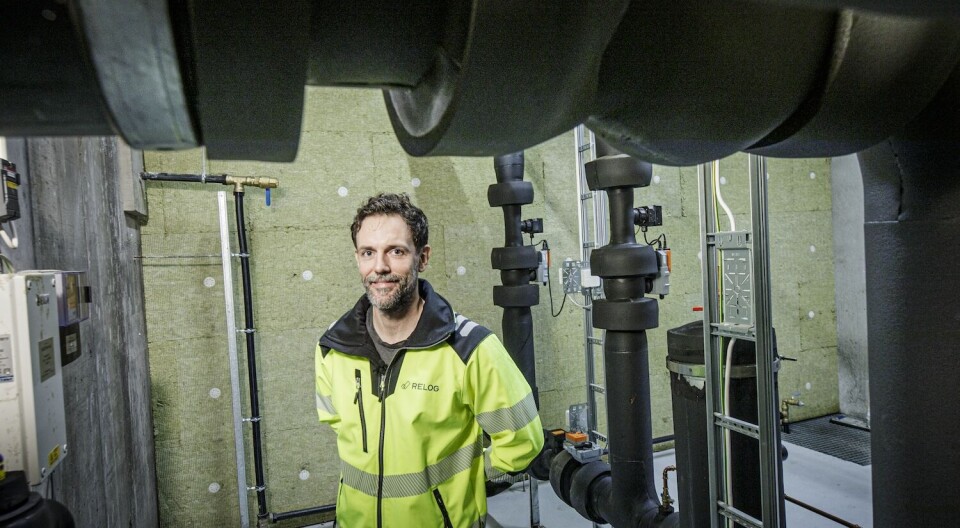THIS CONTENT IS BROUGHT TO YOU BY THE University of Agder - read more

This is how your food stays refrigerated with half the energy
Artificial intelligence controls the thermostat in the coldstorage, potentially reducing energy consumption by as much as 50 per cent.
Today's buildings are becoming increasingly more complex, particularly those that produce and store their own energy. Such buildings are equipped with systems that can communicate with each other, producing vast amounts of data.
“In such systems, it's challenging to optimise performance,” says Sven Opalic.
Complex technical rules
Opalic works as an energy technology and innovation specialist at Relog. One of his main tasks has been to optimise energy consumption in a large warehouse building located in southwestern Norway.
Early on, he realised the extent of the challenge. With a size of nearly 30,000 square metres, the building serves as a refrigerated warehouse for Rema Distribution. It generates electricity through rooftop solar panels and stores energy in a battery bank equivalent to five Tesla cars.
Additionally, the building features a 300,000-litre pool of water that serves as part of the sprinkler system, but can also be used to store heating and cooling energy.
“When preparing the building for operation in 2018, we had eight full pages of technical operating rules. It wasn't manageable. We could have simplified it, but that would have compromised efficiency,” he says.
Opalic contacted Professor Morten Goodwin at the University of Agder's Centre for Artificial Intelligence Research (CAIR). This led to the doctoral thesis - based on the energy system in the warehouse building at Vagle in southwestern Norway, and how artificial intelligence can be used to make it more efficient.
Creating a simulation
“Each building is unique, so introducing energy management systems requires significant expertise and time,” says Opalic.
To be able to implement the technology in all kinds of buildings, Opalic's system employs reinforcement learning. This means that the artificial intelligence gets to experiment and improve by learning from its mistakes.
It would be unfortunate if a software program were allowed to experiment and fail in a real building. Therefore, a model that simulates the energy systems in the building is first created.
Once the system starts to make good enough choices in the simulation, it can be applied to the actual building’s systems.
Here you can see how the system works in practice:
Inspiring collaboration
Synnøve Gautesen Berg is the director of responsibility and sustainability at Rema Distribution. The company delivers goods to all supermarkets in the Rema 1000 chain in Norway. It is an energy-intensive business that operates many refrigerated and frozen warehouses.
“Having forward-looking property owners like our sister company Relog is extremely valuable. Having access to the kind of expertise that Opalic has acquired is crucial to achieving innovative and effective solutions,” says Berg.
She adds that smart energy management is essential in realising the sustainability goals set by Rema 1000.
“This is a very inspiring collaboration that is taking us in the right direction,” she says.
May deliver significant savings
Sven Opalic believes that automation of this kind can lead to significant savings, although the extent depends on the specific building.
“If a skilled programmer has designed the system in a new building, there may be fewer gains. However, in inefficient buildings that haven't undergone much optimisation, savings of 30 to 50 per cent is possible,” he says.
The research has yielded positive results, and parts of the results have already been implemented at the tested Rema 1000 warehouse. Opalic now aims to facilitate the development of software that can be utilised across multiple buildings.
“Our goal has always been to eliminate bottlenecks. Now, our goal is to test the software on our own buildings to see if our excellent results still hold up in the face of reality,” he says.
Reference:
Opalic, S.M. Advanced Warehouse Energy Storage System Control Using Deep Supervised and Reinforcement Learning, Doctoral dissertation at the University of Agder, 2023.
———
Read the Norwegian version of this article on forskning.no

This content is paid for and presented by the University of Agder
This content is created by the University of Agder's communication staff, who use this platform to communicate science and share results from research with the public. The University of Agder is one of more than 80 owners of ScienceNorway.no. Read more here.
More content from the University of Agder:
-
Research paved the way for better maths courses for multicultural student teachers
-
The law protects the students. What about the teachers?
-
This researcher has helped more economics students pass their maths exams
-
There are many cases of fathers and sons both reaching elite level in football. Why is that?
-
How we used plants to protect ourselves from evil
-
What is it like for nurses to promote health behind bars?




































